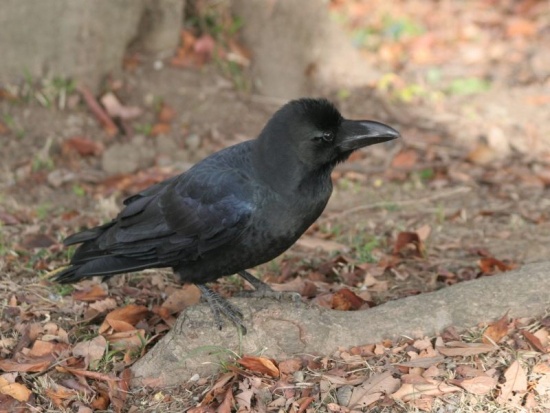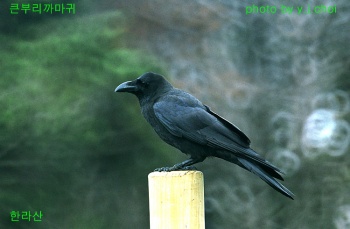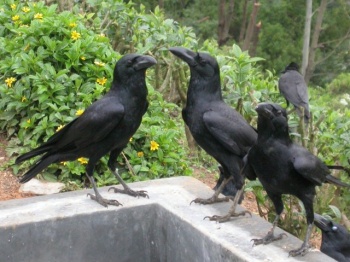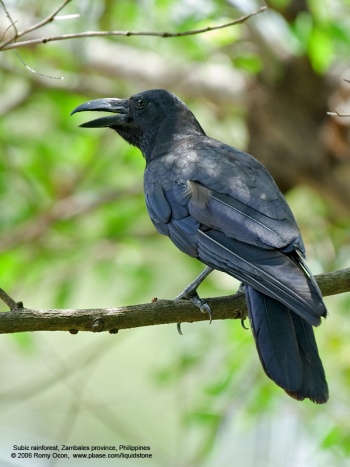(identification, alternative names) |
Aloktewari (talk | contribs) (Ssp. image added ; Gallery created.) |
||
| (2 intermediate revisions by 2 users not shown) | |||
| Line 1: | Line 1: | ||
'''Alternative names: Jungle Crow; Thick-billed Crow; Black Crow; Japanese Crow (''japonensis'', ''connectens'', ''osai''), Eastern Jungle Crow (''levaillantii''); Indian Jungle Crow (''culminatus'')''' | '''Alternative names: Jungle Crow; Thick-billed Crow; Black Crow; Japanese Crow (''japonensis'', ''connectens'', ''osai''), Eastern Jungle Crow (''levaillantii''); Indian Jungle Crow (''culminatus'')''' | ||
[[Image:Large-billed_Crow.jpg|thumb|550px|right|subspecies ''japonensis''<br />Photo by {{user|janha|janha}}<br />Shiba park, Tokyo, [[Japan]], December 2005 ]] | [[Image:Large-billed_Crow.jpg|thumb|550px|right|subspecies ''japonensis''<br />Photo by {{user|janha|janha}}<br />Shiba park, Tokyo, [[Japan]], December 2005 ]] | ||
| − | |||
| − | |||
| − | |||
;[[:Category:Corvus|Corvus]] macrorhynchos | ;[[:Category:Corvus|Corvus]] macrorhynchos | ||
==Identification== | ==Identification== | ||
| Line 14: | Line 11: | ||
* Black legs and bill | * Black legs and bill | ||
Sexes similar. Juveniles with less glossy plumage and a smoky blue iris. | Sexes similar. Juveniles with less glossy plumage and a smoky blue iris. | ||
| + | [[Image:Mandschuricus.jpg|thumb|350px|right|subspecies ''mandshuricus''<br />Photo by {{user|ilovebird|ilovebird}}<br />[[South Korea]]]] | ||
====Similar species==== | ====Similar species==== | ||
Very similar to [[Slender-billed Crow]]. Note the concealed culmen base in Large-billed Crow, the longer tail in flight and the more obviously fingered primaries. May also be confused with [[Carrion Crow]] and [[Common Raven]] in parts of its range. | Very similar to [[Slender-billed Crow]]. Note the concealed culmen base in Large-billed Crow, the longer tail in flight and the more obviously fingered primaries. May also be confused with [[Carrion Crow]] and [[Common Raven]] in parts of its range. | ||
| Line 21: | Line 19: | ||
Common and widespread in most of its range. Rather rare in [[Borneo]]. Records from [[Iran]], north [[Afghanistan]], [[Turkmenistan]] and [[Tajikistan]] are probably erroneous. | Common and widespread in most of its range. Rather rare in [[Borneo]]. Records from [[Iran]], north [[Afghanistan]], [[Turkmenistan]] and [[Tajikistan]] are probably erroneous. | ||
==Taxonomy== | ==Taxonomy== | ||
| + | [[Image:331Dscn7222 Large-billed Crow.jpg|thumb|350px|right|subspecies ''culminatus''<br />Photo by {{user|Dave+Smith|Dave Smith}}<br />[[Sri Lanka]], August 2003]] | ||
There are eleven subspecies in this taxon which could be split into several species in the future: | There are eleven subspecies in this taxon which could be split into several species in the future: | ||
* ''Japonensis'' group | * ''Japonensis'' group | ||
| Line 39: | Line 38: | ||
More subspecies are proposed but usually not accepted. The taxonomy of this species is not yet solved. | More subspecies are proposed but usually not accepted. The taxonomy of this species is not yet solved. | ||
==Habitat== | ==Habitat== | ||
| + | [[Image:10256IMG 9763-800x600.jpg|thumb|350px|right|subspecies ''philippinus''<br />Photo by {{user|Romy+Ocon|Romy Ocon}}<br />Subic rainforest, Zambales province, [[Philippines]], June 2006 ]] | ||
Woodland, parks and gardens. In north of range often near rivers and settlements near rivers.<br /> | Woodland, parks and gardens. In north of range often near rivers and settlements near rivers.<br /> | ||
Up to 2000 m in [[Sri Lanka]], 4500m in Sikkim and 5000m in [[Tibet]]. Known to follow mountaineers as high as 6400m. | Up to 2000 m in [[Sri Lanka]], 4500m in Sikkim and 5000m in [[Tibet]]. Known to follow mountaineers as high as 6400m. | ||
| Line 46: | Line 46: | ||
The nest is a platform of twigs, usually high up on a tree with a preference for tall conifers like Fir or Pine. There are normally 3-5 eggs laid and they are incubated for 17-19 days. The young are fledged usually by about the 35th day. <br /> | The nest is a platform of twigs, usually high up on a tree with a preference for tall conifers like Fir or Pine. There are normally 3-5 eggs laid and they are incubated for 17-19 days. The young are fledged usually by about the 35th day. <br /> | ||
A resident species. Birds of northern populations move to the coast (ice-free river-mouths) in winter. | A resident species. Birds of northern populations move to the coast (ice-free river-mouths) in winter. | ||
| + | ==Gallery== | ||
| + | Click images to see larger version | ||
| + | <gallery> | ||
| + | Image:thick-billed_crow_alok.JPG|Subsp. intermedius<br />By {{user|aloktewari|Alok Tewari}}<br />Bairagarh, Dist. Chamba, Alt. 7900 ft, [[India]], June 2014 | ||
| + | </gallery> | ||
==References== | ==References== | ||
| − | #{{Ref-Clements6thDec08}}#{{Ref-HBWVol14}}#{{Ref-RasmussenAnderton05}} | + | #{{Ref-Clements6thDec08}}#{{Ref-HBWVol14}}#{{Ref-RasmussenAnderton05}}#[http://www.birdforum.net/showthread.php?t=146179 Birdforum thread] discussing the large number of potential future splits of this species |
{{Ref}} | {{Ref}} | ||
==External Links== | ==External Links== | ||
{{GSearch|Corvus+macrorhynchos}} | {{GSearch|Corvus+macrorhynchos}} | ||
[[Category:Birds]][[Category:Corvus]] | [[Category:Birds]][[Category:Corvus]] | ||
Revision as of 06:38, 24 October 2016
Alternative names: Jungle Crow; Thick-billed Crow; Black Crow; Japanese Crow (japonensis, connectens, osai), Eastern Jungle Crow (levaillantii); Indian Jungle Crow (culminatus)
- Corvus macrorhynchos
Identification
46 - 59cm. The different subspecies differ greatly in size.
- Long bill with the upper mandible quite thick and arched, making it look heavy. The bill size differs greatly with the subspecies.
- Macrorhynchus with a distinctively peaked forehead, other subspecies to a lesser extent
- Dark greyish plumage from the back of the head, neck, shoulders and lower body. Almost black in Indian forms.
- Wings, tail, face and throat are glossy black
- Dark brown iris
- Black legs and bill
Sexes similar. Juveniles with less glossy plumage and a smoky blue iris.
Similar species
Very similar to Slender-billed Crow. Note the concealed culmen base in Large-billed Crow, the longer tail in flight and the more obviously fingered primaries. May also be confused with Carrion Crow and Common Raven in parts of its range.
Distribution
Found in south and east Asia.
From Afghanistan over the Indian Subcontinent, the Himalayas and central, south and east China to Korea, the far east of Russia to Japan. Also to Burma, Thailand, Indochina, peninsular Malaysia to Sumatra, Java, Borneo and the Sundas to Timor and Wetar. A regional form occurs on the Philippines.
Common and widespread in most of its range. Rather rare in Borneo. Records from Iran, north Afghanistan, Turkmenistan and Tajikistan are probably erroneous.
Taxonomy
There are eleven subspecies in this taxon which could be split into several species in the future:
- Japonensis group
- C. m. intermedius in east Afghanistan, Pakistan, along the Himalayas to south Tibet and north Nepal
- C. m. tibetosinensis in Tibet, eastern Himalayas (east from Bhutan), north Burma and extreme south China
- C. m. mandshuricus in the Russian Far East, Korea, Sakhalin and northeast China
- C. m. japonensis in Japan and south Sakhalin
- C. m. connectens on Amami Oshima and Ryukyu Island (Japan)
- C. m. osai on southern Ryukyu Islands
- Levaillantii group
- Macrorhynchos group
- Philippinus group
- C. m. philippinus in Philippines
More subspecies are proposed but usually not accepted. The taxonomy of this species is not yet solved.
Habitat
Woodland, parks and gardens. In north of range often near rivers and settlements near rivers.
Up to 2000 m in Sri Lanka, 4500m in Sikkim and 5000m in Tibet. Known to follow mountaineers as high as 6400m.
Behaviour
Feeds on carrion of all kinds. Forages along shorelines and roadsides, robs bird nests, steals food from vulture nests, kills palm-squirrels and rodents, frogs, lizards, crabs and insects. Takes also fruit, nectar and petals.
Usually seen in pairs or family parties, often associating with other birds like House Crow.
The nest is a platform of twigs, usually high up on a tree with a preference for tall conifers like Fir or Pine. There are normally 3-5 eggs laid and they are incubated for 17-19 days. The young are fledged usually by about the 35th day.
A resident species. Birds of northern populations move to the coast (ice-free river-mouths) in winter.
Gallery
Click images to see larger version
Subsp. intermedius
By Alok Tewari
Bairagarh, Dist. Chamba, Alt. 7900 ft, India, June 2014
References
- Clements, JF. 2008. The Clements Checklist of Birds of the World. 6th ed., with updates to December 2008. Ithaca: Cornell Univ. Press. ISBN 978-0801445019.
- Del Hoyo, J, A Elliott, and D Christie, eds. 2009. Handbook of the Birds of the World. Volume 14: Bush-shrikes to Old World Sparrows. Barcelona: Lynx Edicions. ISBN 978-8496553507
- Rasmussen, PC and JC Anderton. 2005. Birds of South Asia: The Ripley Guide. Barcelona: Lynx Edicions. ISBN 978-8487334672
- Birdforum thread discussing the large number of potential future splits of this species
Recommended Citation
- BirdForum Opus contributors. (2024) Large-billed Crow. In: BirdForum, the forum for wild birds and birding. Retrieved 25 April 2024 from https://www.birdforum.net/opus/Large-billed_Crow








